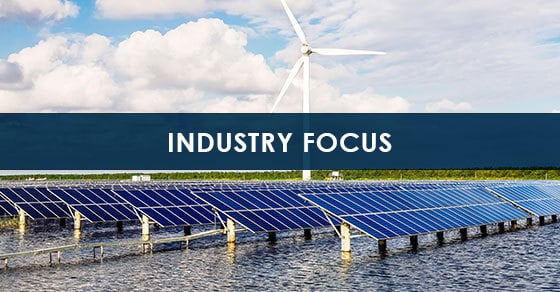A new report from the World Bank Group looks at how mineral demand will be affected by the ongoing transition to renewable energy technologies – a hot topic as of late. As many along the way have voiced, a clean energy future will place significant demand on mineral resources, particularly metals.
About the Report
It is widely accepted that clean energy technologies require significantly more material resources than fossil fuel-based electricity; solar panels, electric vehicles, wind turbines, and more, all call for comparatively massive quantities of minerals.
Limiting global warming to at or below 1.5° – 2°C (a goal set by the Paris Agreement) will subsequently require a substantial shift in global energy practices, placing unprecedented demands on mineral resources.
Minerals for Climate Action: The Mineral Intensity of the Clean Energy Transition, examines the depth to which minerals are likely to play a role under different emission-mitigation scenarios up to the year 2050, as the world pursues efforts to combat climate change through clean energy initiatives.
The report emphasizes the findings of a similarly focused 2017 report put out by the group, entitled The Growing Role of Minerals and Metals for a Low Carbon Future. It also comes after a recent statement made by the International Energy Agency regarding the critical nature of reliable mineral supply chains in meeting future energy goals – a fact emphasized by the supply chain challenges brought to light by the COVID-19 pandemic.
Based on six clean energy technologies, the new report considers seventeen materials:
- Aluminum
- Chromium
- Cobalt
- Copper
- Graphite
- Indium
- Iron
- Lead
- Lithium
- Manganese
- Molybdenum
- Neodymium
- Nickel
- Silver
- Titanium
- Vanadium
- Zinc
Key Report Findings
In addition to a treasure trove of data and analyses, the report offers several conclusions. Among them:
Mineral Demand Will be Substantial
While demand will differ depending on the realized climate scenario, minerals will generally be in much higher demand as efforts to implement widespread clean energy technologies ramp up all over the world.
According to the report, current production levels of graphite and lithium would need to increase by almost 500% to meet the anticipated demand in a 2DS (2-degree scenario). Cobalt would require an increase of over 450%. All three materials are critical to lithium-ion battery technology.
The report notes that even minerals experiencing relatively smaller demand increases will still see sizable increases in absolute demand.
Since data in the report does not account for the associated infrastructure required for implementing these technologies (ex., electric vehicle charging stations), demand is likely to be even higher.
Demand Uncertainty Exists
The report recognizes that demand is more stable for some materials than others, as some materials are used in a wide range of clean energy technologies while others are employed in only one or two.
Similarly, in addition to the level of progress achieved, several factors could steer demand for specific minerals in different directions, though the overall requirement of minerals in general will still increase substantially. Potential drivers include preferences and improvements in technologies, material substitutions, policy changes, mineral availability, and other factors. Governments, as well as the mining and energy industries, should be prepared to be flexible to changing market demands.
Recycling & Reuse Alone Won’t Cut It
While recycling and reuse will be an important component of meeting future mineral demands, they alone are not enough; extraction of primary minerals will still be required, particularly with the materials experiencing the highest demand.
The Renewable Energy Path Still Makes Sense
Despite the significant increase in demand for minerals, the move toward a clean energy model still makes sense; according to the group, low-carbon technologies are responsible for just 6% of the emissions that fossil fuel-based approaches generate under a 2DS.
However, the authors also note that while these emissions are substantially lower, they should still be carefully managed through policy framework and advancements in technology.
Additional Gains Exist
In addition to the contributions clean energy will make toward the shift to a low-carbon economy, other potentially significant benefits exist as well.
Limiting the carbon footprint of needed minerals throughout the supply chain could bolster economic growth (as well as limit environmental risks) in developing countries home to these minerals, according to the group.
This potential goes both ways, however, and the authors note that efforts to meet renewable energy goals must be carried out responsibly and sustainably, so as not to come at the expense of environmental or social damages.
Taking Action
In 2019, the World Bank formed the Climate-Smart Mining Initiative, which aims to address the many potential challenges associated with the move toward a low-carbon future by working collaboratively with governments, developers, industries, and civil society to minimize the social, environmental, and climate footprints of the activities essential to the energy transition, ensuring responsible, sustainable, and stable mineral supplies.
The Initiative, which was developed to align with the Sustainable Development Goals and the Paris Agreement, also intends to assist resource-rich developing countries in benefiting from their mineral resources.
Conclusion
The World Bank report makes it clear: mining will be the key to a low-carbon future, with vast amounts of minerals and metals at the center of building and deploying clean energy technologies. The clean energy transition will not only demand more primary minerals, but also improved recycling and end-of-life management strategies, as well as innovation in every aspect of the mineral supply chain. While minerals will allow the transition to clean energy technologies, the activities associated with the transition must be carried out sustainably and responsibly to reap the benefits of the energy transition.
FEECO is a leading provider of custom equipment, process development, and parts and service support to the mining industry. Our diverse experience spans across both primary and secondary mineral resources, from processing spodumene ore into lithium, to recovering metals from e-waste and batteries. For more information on how we support mining, processing, and recycling operations, contact us today!


